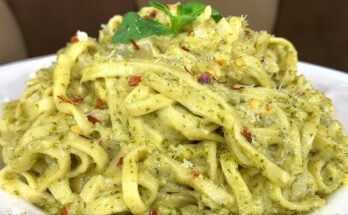Dolmades Recipe: Dolmades are bite-sized rolls of deliciousness wrapped in grape leaves and filled with a savory mixture of rice, herbs, and sometimes meat. They’re one of the most iconic dishes in Mediterranean cuisine, often enjoyed as appetizers or part of a meze platter. While you might see them served at Greek restaurants or in Middle Eastern homes, making dolmades at home is a rewarding experience that allows you to put your own twist on tradition.
The grape leaves impart a unique tangy flavor that blends perfectly with the herbaceous filling. The beauty of dolmades lies in their versatility—you can make them vegetarian, vegan, or meaty, and serve them warm or cold depending on your preference.
Origins and Cultural Significance
Dolmades, or “dolma,” originate from the word “dolmak,” meaning “to fill” in Turkish. They’re deeply rooted in the culinary traditions of the Eastern Mediterranean, Balkans, and the Middle East. Each region has its own version and twist—some add pine nuts and currants, others use lamb or beef. But one thing is clear: dolmades are not just food, they’re a cultural expression.
In Greece, they are often served during holidays or family gatherings, symbolizing love and care. The process of hand-rolling each piece is therapeutic and brings people together, often making it a family activity. Dolmades showcase how food can be both humble and elegant at the same time.
Ingredients You’ll Need
Main Ingredients
Let’s get to the good stuff—what you’ll need in your kitchen to make a batch of dolmades. Here’s a breakdown of the core ingredients:
- Grape Leaves: Around 50 leaves, preferably preserved in brine if fresh ones aren’t available.
- Rice: Short-grain rice like Arborio works best for a sticky texture.
- Onions: Finely chopped; they add sweetness and depth.
- Fresh Herbs: Dill, parsley, and mint are traditional and pack tons of flavor.
- Lemon Juice: For that bright, tangy finish.
- Olive Oil: The soul of Mediterranean cooking—don’t be stingy.
- Salt & Pepper: For seasoning the filling and boiling water.
Each of these ingredients plays an important role. The rice acts as the foundation, the herbs bring fragrance, and the grape leaves wrap it all into neat parcels. Olive oil and lemon juice make everything pop with flavor.
Optional Add-ins and Substitutes
Want to shake things up a bit? Here are some variations and substitutions to make this dish truly yours:
- Meat: Add ground lamb or beef for a heartier version.
- Pine Nuts & Currants: Adds a touch of sweetness and crunch.
- Tomatoes: A bit of grated tomato in the mix adds richness.
- Vegetable Broth: Use it instead of water when cooking for more flavor.
- Quinoa or Bulgur: A modern twist if you’re skipping rice.
If you’re going for a vegan or vegetarian version, just skip the meat and load up on the herbs and nuts. The beauty of dolmades is how they adapt to your tastes while staying true to their roots.
Preparing the Grape Leaves
Fresh vs. Jarred Grape Leaves
Choosing the right grape leaves is crucial. If you’re lucky enough to find fresh grape leaves, blanch them in boiling water for 2-3 minutes to soften them. They’ll be a bit more vibrant and tender than jarred ones.
However, jarred grape leaves in brine are more commonly available and easier to work with. They’ve already been preserved, so you just need to rinse them thoroughly under cold water to remove excess salt and soak them for a few minutes. Lay them out flat and cut off the tough stems before using.
The leaves should be pliable but not mushy. Think of them like little blankets—you want them flexible enough to roll without tearing.
How to Prepare Them for Stuffing
Here’s a quick guide:
- Rinse the leaves under cold water to get rid of the brine.
- Soak them in warm water for about 10–15 minutes.
- Trim the stems if they’re still attached.
- Pat dry using a clean kitchen towel or paper towel.
Lay each leaf shiny-side down on a flat surface. This not only makes rolling easier but also helps the leaf seal better once it’s cooked. Preparation might seem like a chore, but it’s the key to making perfect dolmades.
Making the Filling
Traditional Rice and Herb Mix
The traditional filling for dolmades is light, aromatic, and bursting with herbaceous goodness. Here’s a basic recipe:
- 1 cup of short-grain rice
- 1 finely chopped onion
- 1/4 cup chopped fresh dill
- 1/4 cup chopped fresh mint
- 1/4 cup chopped fresh parsley
- Juice of 1 lemon
- 1/3 cup olive oil
- Salt and pepper to taste
Sauté the onions in olive oil until translucent. Add the rice and stir to coat each grain. Pour in half a cup of water and cook until the water is mostly absorbed. Remove from heat and stir in the chopped herbs, lemon juice, salt, and pepper.
This filling should be only partially cooked before rolling since it will finish cooking inside the grape leaves. The key here is balance—herby, tangy, and well-seasoned without being overpowering.
Adding Meat – A Popular Variation
If you’re in the mood for something more filling, add ground lamb or beef to the mix. Here’s how:
- Brown 1/2 pound of ground meat with the onions.
- Add rice and stir to combine.
- Season generously with salt, pepper, and a dash of cinnamon for an extra layer of flavor.
- Add your herbs and a bit of tomato paste for richness.
Let the filling cool slightly before using. This meaty version is often served warm with a tangy lemon-egg sauce (avgolemono) on top—pure comfort food.
Rolling and Assembling Dolmades
How to Roll Perfect Dolmades
Rolling dolmades is an art, but once you get the hang of it, it’s as satisfying as wrapping little edible gifts. Here’s a simple, foolproof method:
- Lay the grape leaf flat, vein-side up, on a clean surface.
- Place a spoonful of filling near the stem end of the leaf.
- Fold the bottom up over the filling.
- Fold the sides in toward the center.
- Roll upwards tightly but gently, like a burrito.
The key is not to overfill—about a teaspoon to a tablespoon of filling is perfect, depending on the size of the leaf. If you overstuff them, they may burst during cooking.
Another tip? Keep the rolling consistent. Aim for uniform size and shape so they cook evenly. Don’t worry if your first few look a little wonky; it gets easier as you go.
Want to go pro? Place your rolled dolmades seam-side down so they don’t unravel, and tuck them tightly into the pot to keep everything secure during cooking.
Tips to Prevent Tearing or Leaking
There’s nothing worse than having your dolmades fall apart during cooking. Here’s how to keep that from happening:
- Use pliable leaves: Soaking or blanching helps soften them.
- Don’t overstuff: Leave room for the rice to expand.
- Roll tightly: But not too tight—give the rice room to grow.
- Pack snugly in the pot: Arrange in a circular pattern to prevent movement.
- Cover with extra grape leaves: A little insurance to protect your precious rolls.
- Weigh them down: Place a heatproof plate on top before cooking to hold them in place.
Once you’ve mastered these tips, you’ll roll dolmades like a seasoned chef. You’ll find yourself craving the relaxing rhythm of rolling and assembling, and your guests will be asking for seconds before you know it.
Cooking the Dolmades
Simmering to Perfection
After you’ve rolled your dolmades and arranged them tightly in the pot, it’s time to cook them. Here’s how to do it right:
- Layer the bottom of the pot with leftover or torn grape leaves to prevent burning.
- Arrange the dolmades in layers, seam-side down.
- Add a generous drizzle of olive oil and lemon juice over the top.
- Pour in water or broth until just barely covering the dolmades.
- Place a plate or lid smaller than the pot directly on top to hold them down.
Bring the pot to a gentle simmer—not a full boil—and let it cook covered for about 45 minutes to 1 hour. You’ll know they’re done when the rice is tender and the grape leaves have softened.
Check occasionally and add a bit more hot water if needed. Don’t rush the process—slow cooking allows all the flavors to meld together beautifully. And remember, the olive oil and lemon juice aren’t just for taste—they help keep the dolmades moist and fragrant.
Avgolemono Sauce: The Perfect Finish
Want to take your dolmades to the next level? Drizzle them with avgolemono sauce—a creamy, tangy Greek sauce made with eggs and lemon. Here’s a quick version:
- 2 eggs
- Juice of 2 lemons
- 1 cup of the hot broth from cooking dolmades
Whisk the eggs and lemon juice in a bowl. Slowly add the hot broth while whisking constantly to temper the eggs. Pour the sauce back into the pot with the dolmades and heat gently until it thickens slightly (don’t boil, or it might curdle).
This sauce adds richness and a silky texture that elevates your dish from delicious to unforgettable.
Serving Suggestions
Hot or Cold? Best Ways to Serve Dolmades
One of the beautiful things about dolmades is how versatile they are when it comes to serving. You can enjoy them hot, room temperature, or chilled, depending on the filling and your personal preference.
- Vegetarian dolmades (with rice and herbs) are typically served cold as an appetizer or side dish. They’re perfect for mezze platters or picnics.
- Meat-filled dolmades are often served warm, sometimes with that creamy avgolemono sauce, as a hearty main or part of a full dinner spread.
To serve:
- Arrange dolmades on a platter.
- Drizzle with olive oil.
- Garnish with lemon wedges and a sprinkle of fresh herbs.
- Serve with a side of Greek yogurt, tzatziki, or feta cheese.
If you’re going for presentation points, add olives, roasted peppers, or cucumber slices to the platter. It turns your dish into a visual feast as well as a flavorful one.
Pairing with Sides and Drinks
Dolmades play nicely with a whole range of accompaniments. Here are a few tried-and-true pairings:
Side Dishes:
- Greek salad
- Tzatziki or labneh
- Pita bread and hummus
- Roasted vegetables
Drinks:
- A crisp white wine like Assyrtiko
- Retsina (a traditional Greek wine)
- Mint lemonade or sparkling water with lemon
Whether you’re serving them as part of a casual lunch or an elegant dinner, dolmades add a burst of Mediterranean charm to any table. And the best part? They make excellent leftovers.
Storage and Reheating Tips
How to Store Dolmades
Leftover dolmades? Lucky you! These flavorful rolls store beautifully and often taste even better the next day.
- Refrigerator: Place in an airtight container and drizzle with a bit of olive oil to keep them from drying out. They’ll stay fresh for up to 5 days.
- Freezer: Yes, you can freeze dolmades! Lay them flat on a baking sheet to freeze individually, then transfer to a freezer bag. They’ll last up to 3 months. Just note that grape leaves may get a little softer upon thawing.
If freezing meat-filled dolmades, label and date the bag to keep track. Always thaw in the refrigerator before reheating.
Best Methods to Reheat
- Microwave: Cover with a damp paper towel and heat in 30-second bursts.
- Stovetop: Place in a skillet with a splash of broth or water, cover, and heat gently.
- Oven: Cover with foil and bake at 325°F (160°C) for 15–20 minutes.
Avoid overheating, especially with vegetarian dolmades, as they’re delicate and can fall apart if handled too roughly.
Common Mistakes to Avoid
Beginner Pitfalls and How to Fix Them
Making dolmades might seem intimidating, but with a little guidance, it’s totally doable. Here are some of the most common mistakes beginners make—and how to avoid them:
1. Overstuffing the Leaves
Don’t pack in too much filling. Rice expands as it cooks, and overfilled leaves will burst or unroll.
2. Using Cold Filling
Let the filling come to room temperature before rolling. Cold filling makes the leaves stiff and harder to roll.
3. Not Rinsing the Leaves
Jarred grape leaves can be extremely salty. Always rinse them well to avoid an overly briny dish.
4. Cooking at Too High a Heat
Dolmades should be simmered gently. Boiling will make them tough and may cause them to unravel.
5. Not Using Enough Liquid
Make sure they’re mostly covered with broth or water while cooking, or the rice won’t cook evenly.
Avoiding these simple mistakes can be the difference between mushy rolls and Mediterranean perfection.
Health Benefits of Dolmades
Nutritious and Delicious
Dolmades aren’t just tasty—they’re packed with nutritional value too, especially if you’re going with the vegetarian version.
Here’s what you’re getting in every bite:
- Grape leaves: Low in calories, rich in fiber, vitamin A, K, and antioxidants.
- Rice: Source of energy and gentle on the stomach.
- Herbs: Mint, parsley, and dill support digestion and add anti-inflammatory properties.
- Olive oil: Heart-healthy fats that reduce inflammation.
- Lemon juice: High in vitamin C and aids in iron absorption.
The meat version adds protein and iron, making dolmades a balanced, wholesome choice for almost any diet. Plus, they’re gluten-free and easily made vegan—what’s not to love?
FAQs about Dolmades Recipe
1. Can I use collard greens or cabbage instead of grape leaves?
Yes, you can substitute grape leaves with blanched collard greens or cabbage. The flavor will differ, but they’ll still taste great.
2. How long can I store dolmades in the fridge?
Up to 5 days in an airtight container. Add olive oil to keep them moist.
3. Are dolmades vegan?
They can be! Just skip the meat and use a rice and herb filling.
4. What’s the best type of rice for dolmades?
Short-grain rice like Arborio is best because it sticks together nicely and cooks evenly.
5. Can I make dolmades ahead of time?
Absolutely. In fact, they often taste better the next day once the flavors have melded.
Conclusion
Dolmades are more than just a dish—they’re a celebration of flavor, tradition, and culinary craftsmanship. Whether you’re making them for a cozy family dinner or impressing guests at a party, this step-by-step guide ensures you’ll roll up perfect, tasty dolmades every time.
From choosing the best grape leaves to mastering the art of the roll, every step adds up to a dish that’s as rewarding to make as it is to eat. So grab those grape leaves, roll up your sleeves, and let the magic begin—because nothing says “homemade” like a platter of lovingly wrapped dolmades.



